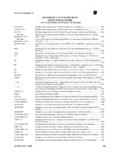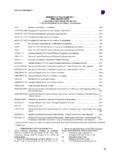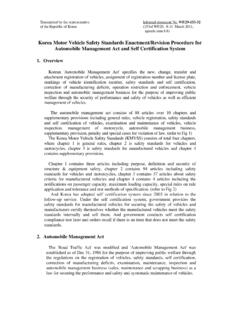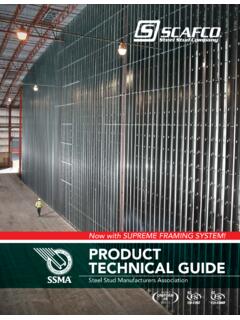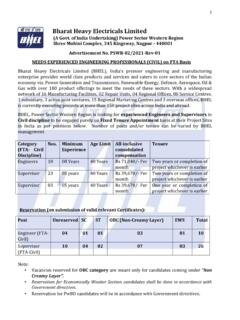Transcription of AN OVERVIEW OF THE ANSI Z359 FALL PROTECTION CODE
1 AN OVERVIEW OF THE ANSI Z359 FALL PROTECTION CODEFEBRUARY 16, - 2012 - - - - - - - - - - 20174668910111213141416171820 The American National standards Institute (ANSI) was founded in 1918 (originally the American Engineering standards Committee - AESC) to standardize development of certain areas of manufacturing, safety, and engineering. Its first major project in 1919 focused on pipe thread dimensions, followed shortly thereafter in 1920 by the ambitious American Standard Safety Code, which sought to synchronize the disparate and confusing nationwide safety laws and standards that served more as an inhibitor to, rather than a facilitator of, jobsite safety.
2 Fast-forward nearly a century and ANSI has expanded its reach into the automotive and aerospace fields, software, electronics, energy, and a host of other industries too numerous to mention here. For those in fall PROTECTION , ANSI made its entry into the field in 1992 with the introduction of the ANSI/ASSE American National Standard for personal fall arrest systems in non-construction occupations. In the 25 years since its initial release, the ANSI Z359 body of standards have grown considerably, and have become the backbone for design, testing, and performance for most of INTRODUCTION4 INTRODUCTIONthe products used by workers at height around the globe. This document serves as a brief OVERVIEW of the entire ANSI Z359 standards catalog known as The Fall PROTECTION Code, and highlights the latest revisions of each standard within the code, focusing on product design, testing, and performance.
3 Please refer to the full versions of the standard for complete information. It should be noted that adhering to ANSI standards is voluntary, but the standards reflect the latest findings (via regular revisions) by engineers and industry professionals regarding materials and methods to protect workers at height. However, given the degree of expertise and leadership shown by the ANSI committee, legally-binding regulatory bodies such as OSHA and CSA frequently refer to ANSI standards when creating their own regulations. The following information provides only a summary of the latest, major components of each standard within the Z359 Fall PROTECTION Code. The information is not intended to replace the full ANSI suite of standards , and is based solely on Pure Safety s understanding of the ANSI Z359 Fall PROTECTION 2012 Definitions and Nomenclature Used for Fall PROTECTION and Fall Arrest Released in 2012, is the dictionary for navigating the other Z359 standards .
4 Like any industry or field, fall PROTECTION is rife with technical and not-so-technical terminology. This standard clarifies terms so that fall PROTECTION professionals can be as precise as possible regarding product application, design, and intent. Since so many terms ANSI uses come from our colloquial, everyday language, providing their exact definition in relation to fall PROTECTION helps to get professionals on the same page, regardless of locale or position within the is a unique standard in that it is one of only two that are available for free. This standard is essential reading for anyone in or around the fall PROTECTION industry, and is available for download on the ANSI website: The Fall PROTECTION Code is the original ANSI fall PROTECTION standard, and was released in 1992, reaffirmed in 1999, and revised in 2007.
5 In its original form, established ..requirements for performance, design, marking, qualification, instruction, training, inspection, use, maintenance and removal from service of full body harnesses, connectors, lanyards, energy THE FALL PROTECTION CODE6 THE FALL PROTECTION CODE absorbers, anchorage connectors, fall arresters, vertical lifelines and self-retracting lanyards. As might be expected, to keep contained the entire suite of requirements in a single standard would be a difficult turned out to be the case, and shortly after was revised in 2007, ANSI began to release individual standards focused on a narrower scope of the fall PROTECTION code. By 2016, the 2007 revision was all but obsolete, its standards having been split into smaller individual standards that provide a greater degree of clarity and direction than the previous all-encompassing a result, in August of 2016, ANSI approved the latest revision of , which changed its scope from that of a product standard to a sort of table of contents, for the other individual standards .
6 Now only provides basic information on the scope of each standard. Since is no longer a product standard, new products may no longer be marked with the standard, and instead must comply with the individual standard by which they are now governed. This does not mean that products marked with the standard are unsafe or need to be removed from service, just that future products must be marked to the new, product-specific FALL PROTECTION Minimum Requirements for a Comprehensive Managed Fall PROTECTION Program sets the ..minimum requirements of a fall PROTECTION program that will enable an employer to identify, evaluate, eliminate, or control fall hazards in the workplace.
7 This is an employer and end user focused standard that helps ensure employers, when creating a fall PROTECTION plan, are as inclusive as possible, and account for all aspects of the plan from record-keeping, training, inspections, and delegation of responsibilities. Inherent in this standard is that it is the responsibility of the employer to create the fall PROTECTION plan, and to adhere to the recommendations therein. defines the duties and responsibilities required of jobsite staff including program administrators, qualified persons, and trainers, and sets minimum training intervals for all staff so that they remain proficient in the use and understanding of fall PROTECTION equipment and practices.
8 Although primarily an administrative standard, does establish some general requirements for fall PROTECTION systems. For example, it restricts maximum arrest forces to 1,800 lbs., as well as prohibits travel restraint systems on any roof with a slope over 4:12, preferring fall arrest instead. It also sets minimum required anchorage connector strength based on intended application (for example, 5,000 lbs. for arrest and 1,000 lbs. for restraint), and establishes minimum static load requirements for both certified and non-certified , provides guidance on the inspection, maintenance, and storage of fall PROTECTION and rescue equipment, their removal from service (if necessary), and managing incident and rescue events.
9 This information is used by program administrators to 8generate local policy and procedures based on their specific application that conforms to ANSI standards . Of note is the necessity of contacting local rescue authorities, determining capability limits, and recording and reviewing procedure with the jobsite competent person before posting the written Safety Requirements for Lanyards & Positioning is the first of the Z359 standards that specifically addresses fall PROTECTION product design, manufacture, testing, and performance requirements. focuses on lanyards and [work] positioning lanyards only. This is a change from the previous revision of 2007, which focused on positioning and travel restraint systems, and included other components such as rope adjusters, full body harnesses, and positioning harnesses in addition to lanyards and positioning lanyards.
10 The 2017 revision removes harnesses from its scope, and leaves them to their own standard. Note that shock absorbing lanyards are NOT covered by the standard, even though they may technically be used in travel restraint applications. For information on shock absorbing lanyards, see and positioning lanyards may be made in any length and be constructed from wire rope or any synthetic material, provided they meet the requirements of Any means of adjustment on lanyards shall automatically stop if the adjuster is released. Lanyards must be tested to withstand a static load of 5,000 lbs.; adjustable lanyards must maintain their length when subjected to a load of 1,000 lbs.
